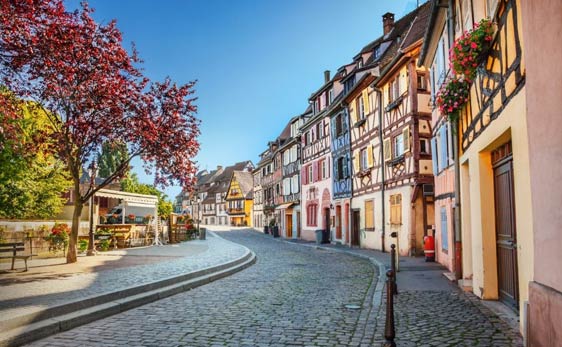5 Reasons to Put Alsace, France at the Top of Your Travel List
By Tuula Rampont
Bordering Germany and Switzerland, France’s northeastern region of Alsace is a place of wonder and beauty. Far from the traditional French travel route preferred by many, this corner of romantic, flower-laden villages and half-timbered homes takes your spirit far from the chic boulevards of Paris, or the shimmering beaches of the Côte d’Azur, and introduces you to a cultural mash-up some 200 years in the making.
Delicate croissants share counter-space with hearty kouglof cakes—their regal appearance coming from the crown-like mold in which these lofty brioches are baked. Imbibed with rum, or one of Alsace’s many fruit liqueurs like kirsch (made from fermented cherries), they are one of the classic symbols of the northeast.
At the local bistro, also known as a winstub, the region’s dry white wines, like riesling or pinot blanc, stand shoulder-to-shoulder with steins filled with well-known favorites like Kronenbourg or Fischer. The beer-producing capital of France, Alsace is the home to several national brands, with independent microbreweries (microbrasseries) running operations in local villages and larger towns.
The pungent aroma of choucroute (sauerkraut) fills the air, and you might just start to wonder if you took a wrong turn somewhere along the Rhine.
Indeed, the history of the region is a push-pull affair between France and Germany, with Alsace becoming a full-fledged part of northeastern France in 1945—after having switched flags an eye-popping five times since 1861.
While spoken Alsatian, a dialect similar to Swiss German, is in relative decline, it’s hard to miss the other markers of German influence, which seem to weave their way seamlessly through Alsace’s two départements (a French county)—the Haut Rhin and the Bas Rhin.
From fairytale architecture, leaving a trail of cozy, church-spire angled villages cut from the pages of a Grimm fable, to the culinary traditions of hearty, belly-warming dishes like pork-laden Baeckeoffe stew and the creamy wood-fired flatbread, Flammekueche, a trip to Alsace is both a scenic delight and a cultural exploration.
Leave your notion of haute couture and haughty attitudes behind, and discover a warm and welcoming corner of la belle France, where traditions run high and the wine flows freely.
Here are five reasons to put Alsace on the top of your travel list:
1. The Alsace Wine Route
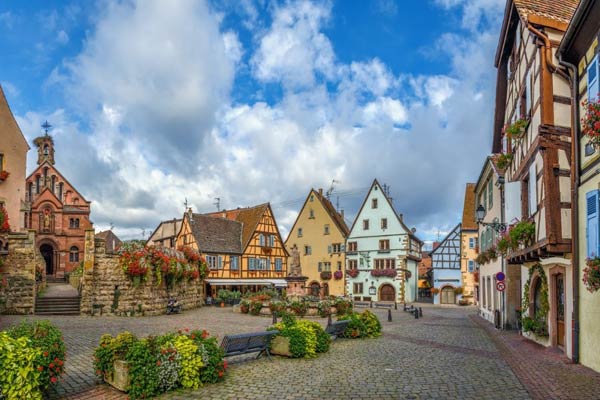
The real breakout star of the region is the well-known, and well-traveled, Alsace Wine Route (La Route des Vins d’Alsace). Spanning both the Haut Rhin and the Bas Rhin departments, this trail of the who’s who in the Alsatian appellation is both a smorgasbord for wine-enthusiasts and a paradise for nature-lovers.
The over 100-mile route winds its way through some of the most beautiful villages in France, which have elevated food and wine-pairings to an artform. The medieval gem, Colmar, with its flower-lined canals, elegant covered market, and centrally located cafés and bistros, is an excellent jumping-off point.
Flying into nearby Basel-Mulhouse-Freiburg airport, visitors can sample Alsace’s white wines (and one red varietal, pinot noir) which include pinot blanc, muscat, pinot gris, Gewurztraminer, and the sparkling crémant d’Alsace—similar in taste and production to Champagne. Expect to taste up to seven wines in one go, keeping in mind that most wine-tasting is free in France.
Stay on in Colmar to dine at a local winstub, or splash out at one of the town’s Michelin-star restaurants like Restaurant Girardin (https://www.maisondestetes.com/). Several appealing hotels exist within the city limits like l’Hostellerie Le Maréchal (https://www.hotel-le-marechal.com/fr/hotel-charme-colmar-alsace). Constructed in 1565, this half-timbered hotel and restaurant is situated in the romantic “Petite Venise” neighborhood and looks directly over the canals below.
From Colmar, the wine route continues northward, following the path of the Rhine River towards Strasbourg, and includes stops at captivating villages like Eguisheim, Kaysersberg, and Riquewihr.
The helpful website Wine Route Alsace provides visitors with a step-by-step guide for each stage of the tour, including detailed maps of cycling trails to admire the beauty of the vineyards on two wheels.
2. Five of the Prettiest Villages in All of France
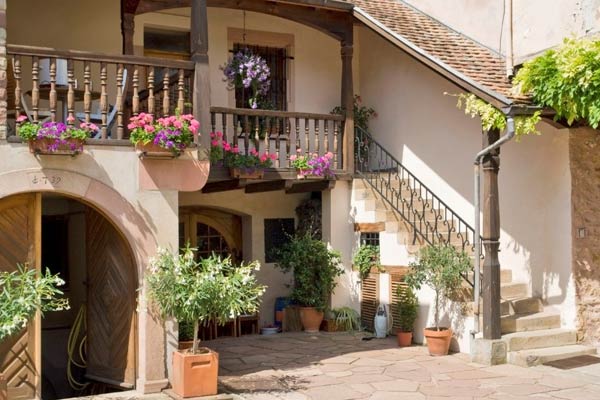
France has a special place in its heart for beauty—whether it be in the perfectly formed layers of a pain au chocolat, the immaculate plating of a three-course dinner, or the particular turn of a Dior dress. If there’s something pretty to be found in France, chances are it’s going to be elevated to revered status.
Enter the country’s “Plus Beaux Village” status, a set of 27 criteria (from physical beauty to historical significance and community spirit) from which a village is chosen as one of the prettiest (plus beau) in all of the country.
I’ve visited a few in my travels, and they are, as expected, absolutely unforgettable.
Alsace is lucky enough to have five of them: Mittelbergheim, Riquewihr, Hunawihr, Eguisheim, and Hunspach. Many are on the wine route, with Equisheim counting the greatest number of wine producers among the bunch—a total of 30. Several wine festivals take place throughout the year, with the Fête des Vignerons (Winemakers Festival) topping the list. Parades featuring period costumes, music concerts, and folkloric dancing animate the celebrations.
3. Strasbourg, the Elegant City with an International Flare

Serving its role as one of the de facto capitals of the European Union, the architecturally pleasing and culturally vibrant city of Strasbourg is home to the European Parliament and European Ombudsman of the European Union–along with a host of international groups and institutions.
After Paris, the city hosts the largest number of international events and congress in the country.
Beyond its governing sensibilities, Strasbourg is a dynamic city with Old World charm. Gourmet restaurants, art galleries, and museums line the historic center, with the Grande Île (Grand Island) classified as a UNESCO World Heritage Site–the stunning Cathedral of Notre-Dame the gem in its cultural crown.
Thought to be one of the most beautiful Gothic structures in all of Europe, its distinctive look is due largely to the red sandstone façade and well-conserved stained-glass windows—dating from the 12th to 14th centuries.
Visit Strasbourg has a list of the city’s must-see sights and events.
4. A Rich, Culinary Tradition
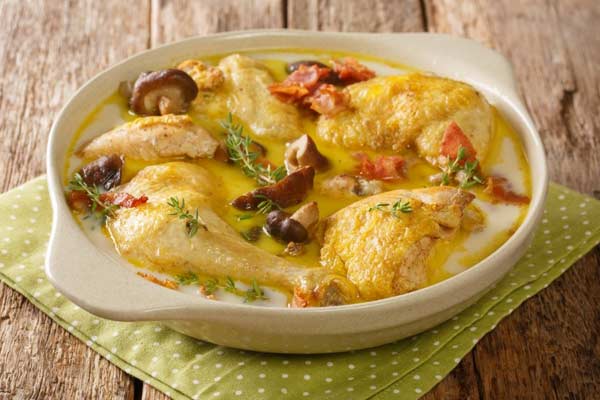
Aside from all of the well-known favorites—tartes, quiches, crêpes, and delicately layered gratins, Alsace borrows heavily from its German roots to offer an interesting twist on traditional French cuisine.
Heavy-handed on pork and sausage dishes, look for comforting stews like potée alsacienne or slow-cooked coq au riesling–the region’s take on coq au vin (chicken in a rich cream sauce).
On the sweet side, the offerings are extensive. Dampfnudel (beignets), cakes made with wine (gâteau au vin blanc and gâteau au vin rouge), tartes made with local fruits (Kirwekueche) and those made with creamy cheeses (Kaeskueche), streusels, and a panoply of assorted Christmas cookies (petits gâteaux de Noël).
5. Some of the Best Christmas Markets in Europe
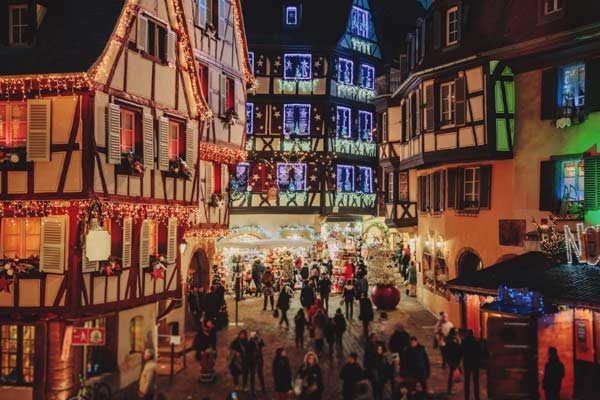
If spring and summer in the northeast are festivals of blooming flowers, with seas of lush vineyards for as far as the eye can see, the winter months are arguably just as spectacular.
These aren’t just main-street affairs; entire Alsatian villages are transformed into Christmas wonderlands—the half-timbered homes and shops decorated from head-to-toe with all the trappings of the season. Festive lights, holly, and fresh mistletoe cover pint-sized chalets which sell everything from handmade ornaments to gingerbread, flavored honeys, teas, and ceramic figurines to make a traditional French crèche (Nativity scene).
Notable favorites include Colmar, Kaysersberg, Eguisheim, and show-stopper, Strasbourg. Find details on the markets, and suggested itineraries at Christmas Alsace.
Full of life, rich in wine-making and culinary traditions, Alsace is a warm and welcoming destination, and a must-see stop on any French itinerary.
Uncovering the Charms of France’s Alsace Region
By Tricia A. Mitchell
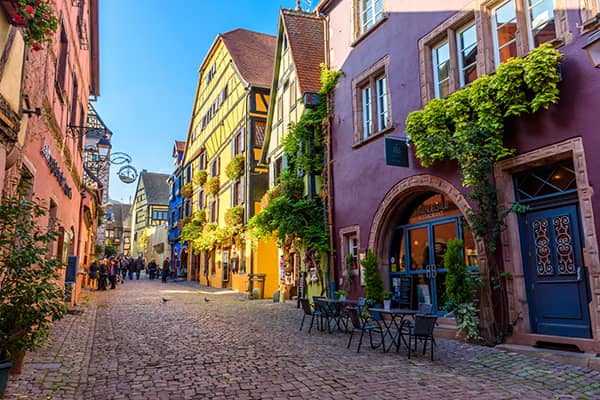
The northeastern French region of Alsace is a land teeming with handsome fortresses and colorful half-timbered villages. Vineyards blanket the landscape as far as the eye can see, and the Vosges Mountains provide a gorgeous backdrop. Storks—the symbol of Alsace— keep things whimsical by building giant nests in prominent perches.
Things here haven’t always been so peaceful. Over the past few centuries, France and Germany have repeatedly fought over this swathe of land. Since Alsace has been ruled by both countries, the resulting culture and Alsatian dialect feel like a blend of the two.
For years, I lived in Germany, just across the border from Alsace and made frequent visits to this lovely corner of France. I was tempted by the cosmopolitan city of Strasbourg, as well as Alsace’s idyllic villages and esteemed wine. Here are a few of my favorite places.
Eclectic Strasbourg

Strasbourg is home to several European Union institutions, one of France’s largest universities, and about 275,000 people. The city is crisscrossed by pretty canals and the Ill River. Buildings reminiscent of gingerbread houses contrast with Art Nouveau architecture and shimmering glass structures. A variety of museums, parks, restaurants, historic churches, boutiques, and big-name French department stores round out the city’s offerings.
Two Strasbourg districts, the Grande-Île (Large Island) and Neustadt, are UNESCO World Heritage sites. The Grande-Île is characterized by labyrinthine lanes and medieval buildings, while Neustadt (German for “new city”) feels more planned. It was constructed when Strasbourg was ruled by Germany.
The Cathédrale Notre-Dame de Strasbourg is a Gothic and Romanesque-style cathedral. Boasting a 466-foot-tall spire that pierces the sky, this 15th-century church was the world’s tallest structure for more than two centuries. Imposing because of its massive size, yet delicate because of its intricate decoration, the cathedral’s pinkish sandstone exterior appears to blush when the light is just right.
Inside the cathedral, there’s an astronomical clock dating back to 1842. The clock showcases a parade of carved figures at 12:30 p.m. most days of the week. For splendid views of Strasbourg’s historic core (even Germany’s Black Forest if the weather is cooperative), ascend 332 steps to the cathedral’s viewing platform. Once here, you’ll be 216 feet above the cobblestone lanes and steep-roofed buildings that radiate out from the cathedral.
After your “medieval spiral staircase workout,” rest your feet and celebrate your accomplishment by pausing for coffee and something sweet at the nearby Maison Kammerzell. Built in the 15th century, the Maison Kammerzell dazzles passersby with 75 stained glass windows and chocolate-colored wood carvings. Inside, there are dining rooms with vaulted ceilings and frescoes. Even if you don’t take a break here, do soak up the extraordinary facade.
The Petite France district is a pleasant 10-minute walk from Strasbourg’s cathedral. It’s a delightful place to stroll, thanks to its waterways, candy-colored buildings, footbridges, and overflowing flower boxes. The district is located on the delta of the Ill River. During medieval times, the river’s waterways provided hydropower for mills and tanneries.
While in the Petite France, be sure to admire the Maison des Tanneurs (Tanners’ House), which was built in 1572. In warmer weather, this half-timbered building is adorned with ruby-red geraniums. Nearby, you’ll also find the formidable Ponts Couverts, a series of bridges and towers dating back to the 13th century. You’ll also pass by the Barrage Vauban, a defensive dam built in the 17th century. The Strasbourg Cathedral and the Ponts Couverts are visible from the Barrage Vauban, making this a superb spot to snap your quintessential souvenir photograph.
Though Strasbourg’s historic core is walkable, another pleasant way to get acquainted with the city is on a boat tour. Several companies allow you to rent a small boat. Fortunately, no license is required. You can also join a group cruise with Strasbourg’s provider, Batorama. During this 70-minute tour, you’ll glide by the main attractions of the Petite France and Neustadt, as well as several European Union institutions.
There is a plethora of museums in Strasbourg—with themes ranging from archaeology and modern art to the city’s history and even African voodoo objects. The Musée des Beaux-Arts de Strasbourg (Fine Arts Museum) is housed in the 18th-century Palais Rohan, which is an elegant attraction in its own right. The museum showcases work from many artists, including Botticelli, Raphael, Rubens, and El Greco. Strasbourg has its own philharmonic orchestra and also hosts opera, theatrical, and dance performances, plus a wide range of musical festivals.
Ribeauvillé
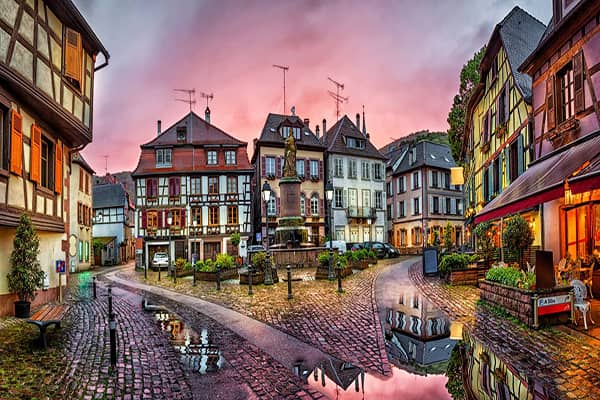
Make sure to check out Ribeauvillé, a town surrounded by a patchwork of vineyards. It is dotted with several defensive towers and intricate fountains sculpted out of pink sandstone. Three fortresses (Girsberg, Haut-Ribeaupierre, and Saint-Ulrich) overlook Ribeauvillé. They were built by the Lords of Ribeaupierre between the 11th and 13th centuries. You can hike to them from Ribeauvillé. What’s more, every September, the town plays host to Alsace’s oldest festival, the Pfifferdaj, or Fiddlers’ Festival. This medieval-themed celebration is replete with parades, costumed revelers, and brass-band performances.
Riquewihr
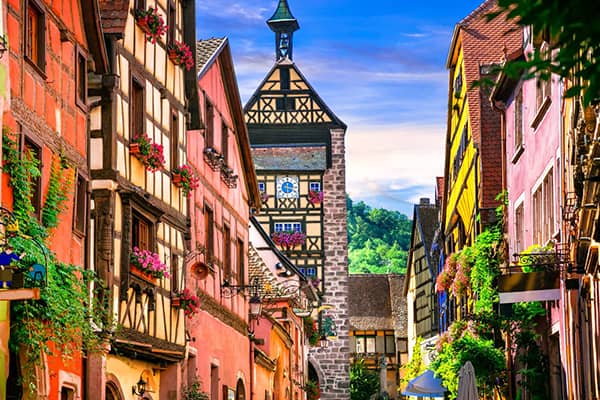
Another village worth seeing is Riquewihr, which has long been celebrated for its high-quality wine. Owing to its rural setting and cultural heritage, it is also a member of Les Plus Beaux Villages de France or the “Most Beautiful Villages in France” association. Like nearby Ribeauvillé, romantic Riquewihr is encircled by rows of vines and centuries-old defensive architecture. Many of the town’s homes and shops sport colorful facades and shutters, as well as ornate iron advertising signs.
Riquewihr is also home to the Maison de Hansi Museum. It’s dedicated to an artist nicknamed Hansi who created some of the region’s most iconic images of traditional life. As you explore Alsace, you’ll notice Hansi’s colorfully dressed characters adorning the pages of children’s books, emblazoned on fabrics, and even decorating wine bottles.
Colmar
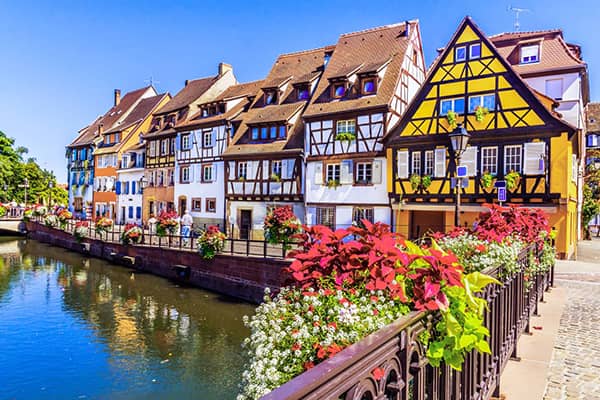
U.S. visitors should be sure to visit Colmar, the birthplace of Frédéric Auguste Bartholdi, the sculptor who designed the Statue of Liberty. His legacy is preserved here, with a museum dedicated to Bartholdi, as well as a smaller version of the Statue of Liberty that holds court in the middle of a traffic circle.
The Petite Venise (Little Venice) district is one of Colmar’s prettiest areas. With its jewel-toned, half-timbered buildings, the architecture is decidedly Alsatian and not at all Venetian Gothic. However, as you watch small boats gliding along the canals and admire the buildings hugging the water’s edge, Venice might come to mind.
The Maison des Têtes, a 17th-century house featuring 106 quirky heads rendered in stone on the building’s exterior, is worth a peek. The statue atop the building’s gable was sculpted by Bartholdi in 1902. Today, the property is home to a Michelin-starred restaurant and luxury hotel.
If you like art history, you’ll also want to visit the Musée d’Unterlinden. This museum showcases many treasures, including a Gallo-Roman mosaic and works by Monet and Rodin. Its most famous holding is the Isenheim Altarpiece, painted in the 16th century by artist Matthias Grünewald. It features religious scenes on multiple panels and was originally displayed in the chapel of a monastery hospital.
Featured Image Copyright: ©iStock/adisa

